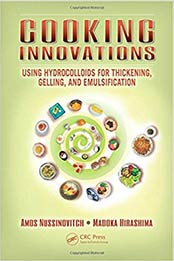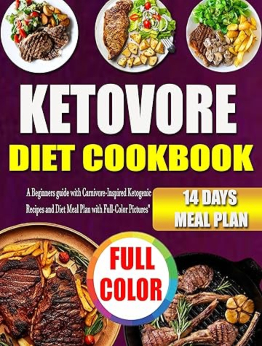
- Title: Cooking Innovations: Using Hydrocolloids for Thickening, Gelling, and Emulsification 1st Edition
- Autor: Amos Nussinovitch, Madoka Hirashima
- Pages: 384
- Publisher (Publication Date): CRC Press; 1 edition (October 9, 2013)
- Language: English
- ISBN-10: 143987588X
- Download File Format: PDF
While hydrocolloids have been used for centuries, it took molecular gastronomy to bring them to the forefront of modern cuisine. They are among the most commonly used ingredients in the food industry, functioning as thickeners, gelling agents, texturizers, stabilizers, and emulsifiers. They also have applications in the areas of edible coatings and flavor release. Although there are many books describing hydrocolloids and their industrial uses, Cooking Innovations: Using Hydrocolloids for Thickening, Gelling, and Emulsification is the first scientific book devoted to the unique applications of hydrocolloids in the kitchen, covering both past uses and future innovations.
Each chapter addresses a particular hydrocolloid, protein hydrocolloid, or protein–polysaccharide complex. Starting with a brief description of the chemical and physical nature of the hydrocolloid, its manufacture, and its biological/toxicological properties, the emphasis is on practical information for both the professional chef and amateur cook. Each chapter includes recipes demonstrating the particular hydrocolloid’s unique abilities in cooking. Several formulations were chosen specifically for food technologists, who will be able to manipulate them for large-scale use or as a starting point for novel industrial formulations.
The book covers the most commonly used hydrocolloids, namely, agar–agar, alginates, carrageenan and furcellaran, cellulose derivatives, curdlan, egg proteins, galactomannans, gelatin, gellan gum, gum arabic, konjac mannan, pectin, starch, and xanthan gum. It also discusses combining multiple hydrocolloids to obtain novel characteristics. This volume serves to inspire cooking students and introduce food technologists to the many uses of hydrocolloids. It is written so that chefs, food engineers, food science students, and other professionals will be able to cull ideas from the recipes and gain an understanding of the capabilities of each hydrocolloid.
![More Cooking Innovations: Novel Hydrocolloids for Special Dishes 1st Edition by Amos Nussinovitch, Madoka Hirashima [1138084093, Format: PDF] 1138084093](https://cookebooks.info/wp-content/uploads/2019/04/1138084093.jpg)
![Edible Films and Coatings for Food Applications by Milda E. Embuscado, Kerry C. Huber [EPUB: 0387928235] Edible Films and Coatings for Food Applications by Milda E. Embuscado, Kerry C. Huber](https://cookebooks.info/wp-content/uploads/2019/12/0387928235.jpg)
![Understanding the Science of Food: From Molecules to Mouthfeel by Sharon Croxford, Emma Stirling [1760296066, Format: EPUB] 1760296066](https://cookebooks.info/wp-content/uploads/2018/09/1760296066.jpg)
![Ideas in Food by Aki Kamozawa, H. Alexander Talbot [PDF: 0307717402] Ideas in Food by Aki Kamozawa, H. Alexander Talbot](https://cookebooks.info/wp-content/uploads/2020/09/0307717402.jpg)
![Food Engineering Innovations Across the Food Supply Chain by Pablo Juliano [EPUB: 0128212926] Food Engineering Innovations Across the Food Supply Chain by Pablo Juliano [EPUB: 0128212926]](https://cookebooks.info/wp-content/uploads/2022/09/0128212926-170x261.jpg)
